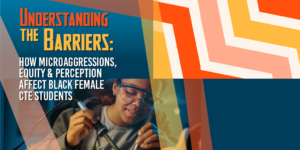This article offers a scholarly inquiry into Black female students’ participation in career and technical education (CTE) and their underrepresentation in such high-paying career fields as science, technology, engineering and mathematics (STEM).
Microaggressions, equity and perception are analyzed for their effect on the population in question. This study will seek to explain how these variables affect the course-taking habits of Black female students in CTE. The literature that concerns Black CTE students and the literature that concerns female CTE students are explored individually; this discussion will further develop readers’ understanding of how multifaceted Black female CTE students are. I separate race and gender in hopes of highlighting the lived experiences of this group and how their identities — and unique challenges — within these two groups intersect, compounding barriers to success in CTE.
What can CTE educators do to increase the rate of enrollment of Black female students in high-wage, high-demand career pathways?
By exploring the literature surrounding this problem, I identified three key issues worthy of investigation:
- Microaggressions
- Equity
- Perception
These issues lie at the heart of the problem. Hill-Collins (1990) used the term “matrix of domination” to illustrate how race, class and gender operate together, instead of as separate categories. Thus, they are cumulative in effect and will simultaneously structure one’s opportunity.

Understanding the specific phenomena at hand requires an understanding of what it is like to be aBlack CTE student, and what it is like to be a female CTE student. Only then can we fully illustrate the incredibly unique barriers affecting Black female students in CTE.
Let’s review the literature on gender-based obstacles.
During the push to pass the Smith-Hughes Act (SHA) of 1917, men’s interests dominated the workforce. Women and women’s groups, however, were also invested in its passing. The Women’s Trade Union League supported the SHA in hopes that it would diversify the career outlook for women across the nation. Yet the body of research provides evidence of a very checkered history in this area. Much like the larger society, CTE has struggled to recruit and retain women in high-paying fields.
In 1972, Title IX was passed to ensure that everyone had equal access to education regardless of sex. This has, of course, compelled female students to seek more equal representation in traditionally male-dominated CTE programs. But women still report feeling as though they don’t fit in to these spaces.
National Coalition for Women and Girls in Education (2012) studied the current effects of Title IX, decades later, and found that, despite the legislation, enrollment patterns persisted. Specifically, barriers include unequal treatment and gender stereotypes. These barriers can be reduced through the continuation and improvement of tracking and data reporting. What sanctions should be used when discrimination is uncovered remains debatable, as studies show that discrimination happens implicitly, in the words that are never spoken.
Microaggressions
Lester et al. (2017) explained that microaggressions may not fall in line with what we would traditionally or legally consider discrimination. Microaggressions can be verbal or nonverbal, conscious or unconscious on the part of the aggressor, and they make the other person or group feel neglected or negated. In CTE classrooms, female students have reported not feeling welcome toask questions in male-dominated fields. Something as simple as the use of exclusively male pronouns can be defined as a microaggression in the classroom.
Equity
Historically, women have clustered in service, hygiene and hospitality industries. On the other hand,men focused on agriculture, construction and mechanics (Gordon >amp; Schultz, 2020). To close the persistent gender equity issue in STEM, female students must be counseled into exploring pathways that have been regarded as nontraditional. Because, when women opt out of high-wage, high-demand CTE pathways, the gender inequality translates into the industries and larger economy. And these trends can have a real impact on the lifetime earning potential of women versus men.
Career and technical education has long provided pathways into high-wage, high-demand STEM careers. The future of women in STEM is intimately connected to the future of women in CTE. The future of women in STEM education correlates directly with women being represented in high-paying fields.
The current course-taking trends in CTE reveal challenges and promises of the future STEM fields for women. Women currently make up 20% of STEM jobs (Toglia, 2013). Yet, at the time of Toglia’s study, women still only made up 6% of CTE electrician students.
The question remains: What can be done? And how does CTE fit into that narrative?
Toglia (2013) examined strategies to improve gender equity in STEM fields, looking specifically at the prospect of mentoring programs for girls. Tate (2017) discussed the benefits of increased outreach from women in information technology careers to school-aged students. Invite women professionals in IT to attendCTE workshops and recruitment events; he argued that they are a key asset in the current fight toward gender equity in CTE. Not only do they serve as a visual representation of students’ future selves, but they also may act as a unique resource to calm fears and address questions.
Let’s review the literature on race-based obstacles.
There still exists a negative perception of career and technical education among some Black families, who only want their students to pursue four-year degrees. Often, individuals will dissuade or be dissuaded from participating in CTE. How do these and other factors affect Black students’ participation in CTE during high school?
Perception
Current perceptions can be traced back to CTE’s inception and its introduction to the Black community. Johnson (1996) recalled the negative stigma of career and technical education associated with the polarizing arguments between Booker T. Washington and W.E.B. DuBois. He stated that, according to administrators, one of the challenges in recruiting students in CTE is the way that Black Americans view technical education. Washington advocated for industrial schooling rather than academic, which many believed he preached as a tool to remove Black Americans from politics and higher academia. DuBois valued skills and vocational education, but he equated higher education with civil rights and political power. In contrast to Washington, DuBois did not think itwise to focus on specific trades as a strategy to uplift the race. These arguments would help to dichotomize the choice of college versus trade deep inside the Black community.
Gordon and Schultz (2020) also referred to the structural challenges of Black Americans’ full and profitable participation in CTE by acknowledging that certain high-wage, high-demand career pathways were not at all available in certain schools. And the high-paying fields of study that were available to Black students were often underfunded. Thus, the investment in career and technical education did not reflect the same benefits or actualize the same reward as their white counterparts. This situation contributed to a longstanding, albeit false, perception that CTE would not deliver profitable returns on education. And it served to maintain the DuBois argument for afocus on academics. Yet, as of 2016, only 21% of Black Americans, aged 25 or older, held a bachelor’s degree (National Center for Education Statistics, 2017)
With equity in mind, CTE has the power to improve educational outcomes of Black female students.
Because race and gender overshadow a student’s broader experience in society, educators must prioritize equity and innovation in recruiting Black female students in high-wage, high-demand CTE programs of study. Remember, career choices do not exist in a vacuum. The special experiences — consequential of their racial construct assignment — cannot be minimized or ignored. Rather than seek to not discuss race, culture, and ethnicity, educators should provide their students and students’ families with tools to explore what meaning can be made from their previous racialized experiences and notions.
Merely recognizing race can cause feelings of discomfort in some professional settings; there is, therefore, this need for career and technical educators to possess a minimum level of comfort with the construct. Better still: an enhanced level of knowledge of the unique struggles, privileges and history of the students’ ethnic background(s).
For young Black girls entering CTE, traditional career exploration models may not produce the intended explorative and open-minded effect. Students’ interests most often reflect the culture, understanding, and the limitations placed on future selves and dreams based on discourse. Black female students often lack the exposure to discover and express ideals about careers in STEM. And this is, perhaps, where the biggest need can be met by educators seeking to serve Black female CTE students.

Anuli I. Phillips, M.A., is a native of St. Thomas, U.S. Virgin Islands, and a former AmeriCorps member. She previously taught World History and student success at a Title I high school and is currently a stay-at-home mom. Phillips graduated with her master’s degree in CTE from theUniversity of Central Florida in 2021, received her graduate certificate in college teaching and leadership from UCF in 2019, and attained her bachelor’s in sociology from Spelman College in 2010.







